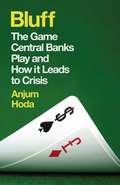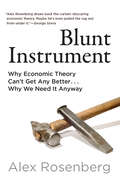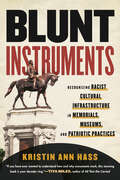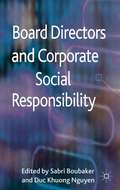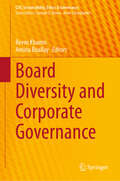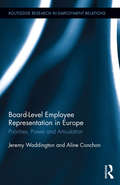- Table View
- List View
Blueprint to a Billion
by David G. ThomsonPraise for BLUEPRINT TO A BILLION "A wonderful, well thought out analysis of entrepreneurship and leadership of a growth company. " -Howard Lester, Chairman, Williams-Sonoma, Inc. "If you dream about growing your business to a billion, this is a fascinating down-to-earth study that you must read. Apply the seven essential principles to your business and you are off and running. Learn about strategy, growth, leadership, team building, and a whole lot more. " -Joe Scarlett, Chairman of the Board, Tractor Supply Company "Blueprint to a Billion is a well-researched and thoughtfully written book that quantifies the growth pattern of America's highest growth companies. " -Professor John Quelch, Senior Associate Dean, Harvard Business School "Eighty percent of the top-performing stocks in the last twenty years were small entrepreneurial companies that had an IPO in the prior eight years. Blueprint to a Billion tells you the seven key things these innovators did in common to become America's greatest growth companies. " -William J. O'Neil, Chairman and Founder Investor's Business Daily, www. investors. com "Thomson has written a masterful work that will catalyze, empower, inspire, motivate, and illuminate entrepreneurs, investors, and policymakers. The world needs this book and will profit from it in manifold ways. " -David M. Darst, Managing Director, Individual Investor Group Chief Investment Strategist, Morgan Stanley
Bluff: The Game Central Banks Play and How It Leads to Crisis
by Anjum HodaThe financial crisis of 2008 was caused by greedy, unscrupulous bankers. Luckily, the Bank of England and the US Federal Reserve were our firefighters. These central banks rescued us from the brink of collapse and resuscitated our economies. Except that isn't the whole story. A simplistic narrative, it glosses over one inconvenient truth - it was the firefighters who started the fire.Experienced asset management adviser Anjum Hoda contends that our central banks have been playing a deceitful game for decades. They've been using interest rates to stimulate the value of assets so that we would feel better off and spend more, thereby generating growth in the 'real' economy. But the supply of cheap money through manipulation of interest rates creates instability not growth, because real-world salaries fail to keep pace.Highly arresting and sobering, Bluff has significant implications for the decisions we make about own finances and even our mid- to long-term life strategies. Hoda's thesis is set out with clarity and power, and her prediction is this - without radical systematic change only greater crises lie ahead.
Blunt Instrument: Why Economic Theory Can't Get Any Better...Why We Need It Anyway
by Alex RosenbergWhy economic theory—with no track-record of predictive success—is still an indispensable tool for protecting civilized life.Economic theory has never gotten any better at prediction. Its explanations are always after the fact. The mathematical models economists have devoted themselves to for more than a century can&’t be improved to enhance their empirical relevance. But from this research program that never paid off, a very useful tool has emerged—game theory. It&’s just what civilized society needs to protect itself from the rapaciousness that condemns all markets to fail. In Blunt Instrument, Alex Rosenberg helps explain to outsiders exactly what they need to make sense of economic theory, and why despite its failures, it&’s still indispensable.Economic theory is something we all should understand because the economy affects us all, and it is economic theorists who shape that economy for good or ill. No less an economist than John Maynard Keynes expressed the point in a memorable quotation: &“Practical men, who believe themselves to be quite exempt from any intellectual influence, are usually the slaves of some defunct economist.&” This book draws back the curtain from the math and the graphs that deliver microeconomic and macroeconomic models. It demystifies the formidable-looking equations, explaining the reasoning behind the math so that outsiders can decide on the theory&’s importance to their own thinking about the economy. Finally, it shows how game theory—the study of strategic choice—emerged from the outlandish idealizations of economic theory. Most importantly, it illuminates how game theory both mitigates the failures of real-world economies and improves the design of important human institutions.
Blunt Instruments: Recognizing Racist Cultural Infrastructure in Memorials, Museums, and Patriotic Practices
by Kristin HassA field guide to the memorials, museums, and practices that commemorate white supremacy in the United States—and how to reimagine a more deeply shared cultural infrastructure for the futureCultural infrastructure has been designed to maintain structures of inequality, and while it doesn&’t seem to be explicitly about race, it often is. Blunt Instruments helps readers identify, contextualize, and name elements of our everyday landscapes and cultural practices that are designed to seem benign or natural but which, in fact, work tirelessly to tell us vital stories about who we are, how we came to be, and who belongs.Examining landmark moments such as the erection of the first American museum and Colin Kaepernick&’s kneeling pledge of allegiance, historian Kristin Hass explores the complicated histories of sites of cultural infrastructure, such as:· the American Museum of Natural History· the Bridge to Freedom in Selma· the Washington Monument· Mount Auburn Cemetery· Kehinde Wiley&’s 2019 sculpture Rumors of War· the Victory Highway· the Alamo CenotaphWith sharp analysis and a broad lens, Hass makes the undeniable case that understanding what cultural infrastructure is, and the deep and broad impact that it has, is essential to understanding how structures of inequity are maintained and how they might be dismantled.
Blurb Your Enthusiasm: An A-Z of Literary Persuasion
by Louise Willder&‘The bookiest book about books you&’ll ever read – I loved it&’ Lucy Mangan &‘Truly delightful...I couldn&’t have had more fun&’ Benjamin Dreyer &‘Very funny, erudite and profound. A delight!&’ Nina Stibbe This is the outside story of books. From blurbs to titles, quotes to (checks jacket) cute animal designs – via author feuds, writing tricks, classic literature, bonkbusters, plot spoilers and publishing secrets – discover why it&’s good to judge a book by its cover. Maybe even this one…
Blurring the Boundaries Through Digital Innovation: Individual, Organizational, and Societal Challenges (Lecture Notes in Information Systems and Organisation #19)
by Fabrizio D'Ascenzo Stefano Za Massimo Magni Alessandra LazazzaraThis book examines the impact of digital innovation on organizations. It reveals how the digital revolution is redefining traditional levels of analysis while at the same time blurring the internal and external boundaries of the organizational environment. It presents a collection of research papers that examine the interaction between Information and Communication Technology (ICT) and behavior from a threefold perspective: First, they analyze individual behavior in terms of specific organizational practices like learning, collaboration and knowledge transfer, as well as the use of ICT within the organization. Second, they explore the dynamics at work on the border between the internal and the external environments by analyzing the organizational impact of ICT usage outside the company, as can be seen in employer branding, consumer behavior and organizational image. Third, they investigate how ICT is being adopted to help face societal challenges outside the company like waste and pollution, smart cities, and e-government. The diversity of views offered makes this book particularly relevant for users, companies, scientists and governments. The content is based on a selection of the best papers - original double-blind peer reviewed contributions -presented at the annual conference of the Italian chapter of AIS, which took place in Rome, Italy, in October 2015, or in other reputable international peer-refereed Information Systems conferences.
Blurry Boundaries of Public and Private International Law: Towards Convergence or Divergent Still?
by Poomintr Sooksripaisarnkit Dharmita PrasadThis book examines interactions and discusses intersectionality between public international law and private international law. With contributions from scholars from USA, Canada, Australia, India and EU, this book brings out truly international perspectives on the topic. The contributions are arranged in four themes—Public international law and private international law: historical and theoretical considerations of the boundary; Harmonisation of private international law by public international law instruments: evaluation of process, problems, and effectiveness; Case studies of intersectionality between public international law and private international law; Future trends in the relationship between public international law and private international law. The ultimate aim of this book is to analyse whether these two legal disciplines become convergent or they are still divergent as usual. With wide coverage spanning across these four themes, the book has takeaways for a wide readership. For scholars and researchers in the fields of public international law and private international law, this book sparks further thoughts and debates in both disciplines and highlight areas for continuing research. For practitioners, this book offers fresh insights and perspectives on contemporaneous issues of significance. This book is also be a great resource for students at both undergraduate and postgraduate levels taking subjects such as public international law or private international law or some related disciplines such as international sale of goods, international trade law or international investment law to advance their knowledge and understanding of the disciplines.
Bo Södersten from Left to Right: Portrait of a Political Economist (Palgrave Studies in the History of Economic Thought)
by Mats LundahlThis book explores the economic work and legacy of Bo Södersten. While best known internationally for his textbook International Economics, Södersten’s influence stretches well beyond this. Through his academic work and newspaper articles, he covered a wide spectrum of topics that often challenged conventional wisdom. By examining his work on housing, the labor-managed economy, development economics, nuclear power, childcare, and higher education, a full view of his diverse work is presented. This book aims to provide insight into the motivations and impact of Bo Södersten during each phase of his life: his academic career, his political life, and his time as a debater-provocateur. It will be relevant to students and researchers interested in Swedish economics, the history of economic thought, and international economics.
Bo's Lasting Lessons: The Legendary Coach Teaches the Timeless Fundamentals of Leadership
by Bo Schembechler John U. BaconThere are very few coaches held higher esteem than Bo Schembechler. As coach of the University of Michigan football team, he won 13 Big Ten titles and finished as the winningest coach in their storied history. But beyond the wins and losses, Bo is best remembered for the remarkable impact he had on his players and fans alike. In BO'S LASTING LESSONS, the coach draws on his years of experience, using first-person anecdotes to deliver timeless lessons on leadership, motivation and responsibility. His distinctive gruff voice leaps from the page. With pithy language, Bo explains that true leadership requires the compassion to actively listen to your people, and then to have the courage to do what is right every time. A big believer in peer pressure and in always making his players accountable for their actions, Schembechler has coached athletes who went on to become professional football players, doctors, lawyers and CEOs.
Board Accountability in Corporate Governance (Routledge Research in Corporate Law)
by Andrew KeayWithin corporate governance the accountability of the board of directors is identified as a major issue by governments, international bodies, professional associations and academic literature. Boards are given significant power in companies, and as a consequence it is argued that they should be accountable for their actions. Drawing on political science, public administration, accounting, and ethics literature, this book examines the concept of accountability and its meaning in the corporate governance context. It examines the rationale for making boards accountable, and outlines the obstacles and drawbacks involved in providing for accountability. The book goes on to examine how current mechanisms for ensuring accountability are assessed in terms of fairness, justice, transparency, practicality, effectiveness and efficiency, before discussing the ways that accountability might be improved. Andrew Keay argues that enhanced accountability can provide better corporate governance, helping to reduce the frequency and severity of financial crises, and improve confidence in company practice. As an in depth study of a key element within the exercise of authority and management in corporate entities, this book will be of great use and interest to researchers and students of corporate governance, business and management, and corporate social responsibility.
Board Design and Management: Considerations for Startups
by Noam Wasserman Anthony K. TjanIndustry and Background Note
Board Design--Time for Action
by Jay W. Lorsch Colin B. CarterThe root cause of the problems that most boards have is inadequate attention to the way each board is designed to handle its responsibilities. There is ample room, however, for each board, within established regulations, and with due consideration to current best practices, to design itself to be most effective in governing its company.
Board Director Dilemmas - Digging into Detail
by Suraj Srinivasan Amram Migdal David G. FubiniThis case explores a new board director who asks a detailed question about a footnote in the lengthy board packet distributed to directors by management. The case allows for discussion about the amount of information and level of detail provided by management, the level of preparation directors engage in prior to board meetings, and the appropriate strategic focus of the board. This case is part of a series of vignettes that capture different dilemmas faced by directors as they join boards of companies and understand the dynamics of the new boards that they join.
Board Director Dilemmas - Pushing Senior Management
by Suraj Srinivasan Amram Migdal David G. FubiniThis case explores a new board director who wants more detail from the management team than his fellow directors are willing to press for. New board director Sam Pesca is frustrated that CFO Alex Marotta provides only a minimal two-page financial summary at board meetings, despite Pesca's requests for more comprehensive information. The other directors object to pressing Marotta for more detail, and young CEO R.J. Oscott asks Pesca to refrain from pressing the CFO. This case is part of a series of vignettes that capture different dilemmas faced by directors as they join boards of companies and understand the dynamics of the new boards that they join.
Board Director Dilemmas-Back the SPAC?
by Suraj Srinivasan Amram Migdal David G. FubiniThis case focuses on a board director of a diversified holding company. The firm's longtime CEO had always exhibited a cautious, methodical approach to growth. Now, the CEO is raising the idea of joining with a special purpose acquisition company (SPAC) to spin off part of the business as a separate company. This strategy shift-a spinoff, use of a SPAC, and accumulation of cash for larger acquisitions-was a dramatic shift for the company, and the board director must consider how to respond.
Board Director Dilemmas-New Year, New Timing
by Suraj Srinivasan Amram Migdal David G. FubiniThis case focuses on a junior partner at a private equity (PE) firm who sits on the board of one of the firm's portfolio companies. In the case, the board member asks the CEO to accelerate a cost-cutting initiative and looks to a seasoned industry veteran who is also a PE-appointed director for reinforcement. When the second board member sides with the CEO instead, the young director must consider how to respond.
Board Directors and Corporate Social Responsibility
by Duc Khuong Nguyen Sabri BoubakerThis volume introduces readers to recent developments in the fields of board of directors and corporate social responsibility. It also provides new insights and perspectives on corporate governance practices in different countries.
Board Directors, Financial Derivatives, and Corporate Governance: The Case of Vietnam
by Tran Thi LienThis book gives readers a look inside the boardrooms and directors’ minds—a desirable but highly challenging task for researchers due to the lack of access to top teams in organizations. This book breaks through that barrier with a mixed-methods investigation of boardrooms in the emerging country of Vietnam particularly on the topic of financial derivatives. Directors are the leading players within the corporate governance framework. The general effectiveness of the board depends on their roles, processes and competencies. Given the scandals marring the history of the financial industry, this book aims to tackle the question of whether board directors have the financial acumen required to handle the tricky instruments of financial derivatives through interviews with board directors and analysis of their organizations. Providing a managerial perspective of financial derivatives, this distinguishes itself from more popular financial engineering books and would be a useful read for government officials, board directors, training organizations and scholars, particularly in Vietnam.
Board Diversity and Corporate Governance (CSR, Sustainability, Ethics & Governance)
by Reem Khamis Amina BuallayThis book brings together research that advances our understanding of the fundamental relationship between board diversity and different aspects of corporate governance, including corporate governance disclosures, board performance, governance characteristics, and ownership structure. The expertly selected chapters deal with related (but not limited) to the following topics: Corporate governance models and diversity; forms of diversity and decisions in the boardroom; Board diversity, corporate disclosure, and intellectual capital disclosures; shareholder activism; differences between private and family firms; Board diversity laws; gender and ethnicity on boards, and going beyond gender aspects of diversity. This book is particularly useful for researchers and practitioner think tanks to understand the state of the art in board diversity research.
Board Diversity at Amazon (A)
by Aiyesha Dey Anu AtluruThe case revolves around the decisions that the board of directors of ecommerce giant Amazon would need to make in response to the controversial letter that activist shareholder CtW investment group sent to Amazon's shareholders, urging them to vote in favor of a proposal aimed at increasing Amazon's board diversity. The board had formally recommended voting against the proposal in the upcoming annual shareholder meeting. The board's stance ignited an internal debate at Amazon, with several employees questioning the diversity of Amazon's leadership relative to other high-profile technology companies. Institutional Shareholder Services and Glass Lewis, two top advisory firms to public company shareholders, remained divided on the issue. The case presents the opportunity to discuss the importance of having a diverse board, in particular, along the dimensions of race and gender. The case is likely to generate spirited debate about the merits of diversity on corporate boards and the role that a powerful multinational company can play in promoting diversity in technology and business. More fundamentally, the case raises the issue of how organizations should measure diversity.
Board Dynamics (Elements in Corporate Governance)
by Philip Stiles<p>Boards of directors are at the apex of organisational decision-making and so are central in ensuring effective corporate governance. But boards are under increasing scrutiny due to the continuing prevalence of scandals and failures. Boards have been viewed as set up to fail because the demands placed upon them cannot effectively be delivered. In this Element, I examine this tension and look at the board as a working group, one which has an input, a process and an output. Through looking at the board as a group, the dynamics of how boards, and the potential for effective and ineffective operation, are highlighted. I conclude with outlining how the future of board dynamics may evolve.</p>
Board Governance in Bank Foundations: The Italian Experience (Contributions to Management Science)
by Chiara Leardini Gina Rossi Sara MoggiBank foundations serve an important purpose in the Italian nonprofit sector. This book presents the legal grounds, areas of intervention, and basic tools involved in the asset management and grant-making activities that such organizations undertake. A special emphasis focuses on the analyses of the organizational structure of bank foundations and the relevant aspects of governance, particularly with regard to the composition, roles, and responsibilities of bank foundation boards. The general reduction in the resources to which they have access requires a new strategy that clearly defines long-term goals and the necessary procedures to achieve them. The topic of strategic planning is therefore also central to this text, which examines its peculiarities, content and governing bodies. The analysis of some case studies provides a better understanding of the manner in which foundations interpret strategic planning and reveals strengths and weaknesses that demand careful attention.
Board Level Employee Representation in Europe: Priorities, Power and Articulation (Routledge Research in Employment Relations #36)
by Jeremy Waddington Aline ConchonBoard Level Employee Representation in Europe analyses the role, activities and networking of board level employee representatives in sixteen European countries and their counterparts operating in companies that have adopted European status. Board level employee representation is viewed as a key element of worker participation in Europe, but there has been only limited international comparative research that establishes what board level employee representatives do and how their activities vary between countries. Based on a large-scale survey distributed to board level employee representatives (circa more than 4,000 respondents), this study identifies the personal characteristics and industrial location of board level employee representatives, what they do and how they interact with other parties within and outside of the company. This study fills in a knowledge gap at a time when policy debates are considering stakeholder models of corporate governance as a means on the way out of the crisis and the achievement of sustainable economies. The book allows direct comparisons between clusters of countries for the first time, as the same survey instrument has been employed in all the participating countries. The research findings demonstrate a large variation in what constitutes board level employee representation in practice, including the relations between board level employee representatives and parties within and external to the company, and the pattern of influence of board level employee representatives on strategic company decision-making. Aimed at practioners, researchers and policymakers alike, this book makes a vital contribution to the field, and will be the definitive work on board-level employee representation for the foreseeable future.
Board of Directors at Medtronic, Inc.
by Jay W. Lorsch Katharina Pick Alexis Chernak Norman SpauldingThe board of directors of Medtronic, Inc., a company known for its commitment to effective corporate governance, must prepare for the departure of Chairman & CEO Bill George and the retirement of four long-time directors. The company had experienced rapid growth in the early 1990s as well as significant change in the composition of its board. Now the Medtronic directors must evaluate how the board has changed, how it will continue to change, and how it should prepare for the future.

